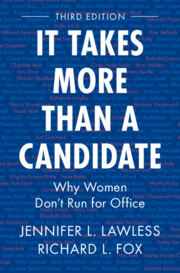Refine search
Actions for selected content:
170 results
Between equality and stagnation: a comparative evaluation of paid parental leave policies in Latin America
-
- Journal:
- International Journal of Law in Context , First View
- Published online by Cambridge University Press:
- 22 September 2025, pp. 1-20
-
- Article
-
- You have access
- Open access
- HTML
- Export citation
Experiences Regarding the Health, Security, and Privacy Problems of Women in Kahramanmaraş Earthquake
-
- Journal:
- Disaster Medicine and Public Health Preparedness / Volume 19 / 2025
- Published online by Cambridge University Press:
- 19 September 2025, e268
-
- Article
-
- You have access
- Open access
- HTML
- Export citation
Women, Gender Inequality, and Citizenship Among Immigrants in Western Europe
-
- Journal:
- Politics & Gender , First View
- Published online by Cambridge University Press:
- 27 August 2025, pp. 1-26
-
- Article
-
- You have access
- Open access
- HTML
- Export citation
Women’s economic empowerment: A global pathway to gender equality?
- Part of
-
- Journal:
- The Economic and Labour Relations Review ,
- Published online by Cambridge University Press:
- 25 July 2025, pp. 1-19
-
- Article
-
- You have access
- Open access
- HTML
- Export citation
7 - Respectable Women
-
- Book:
- A Black Army
- Published online:
- 16 June 2025
- Print publication:
- 17 July 2025, pp 134-155
-
- Chapter
- Export citation

Attitudes toward Political Authoritarianism in Economically Advanced Democracies
- The Role of Gender Values and Norms
-
- Published online:
- 02 July 2025
- Print publication:
- 31 July 2025
-
- Element
- Export citation
The Political Roots of Gender Divergence: Democratic Consolidation and Gender Equality in Taiwan and South Korea
-
- Journal:
- Journal of East Asian Studies / Volume 25 / Issue 1 / March 2025
- Published online by Cambridge University Press:
- 22 May 2025, pp. 98-120
-
- Article
-
- You have access
- Open access
- HTML
- Export citation
Accessing maternity protection: Structural barriers in the informal economy in sub-Saharan Africa
- Part of
-
- Journal:
- The Economic and Labour Relations Review ,
- Published online by Cambridge University Press:
- 28 April 2025, pp. 1-20
-
- Article
- Export citation
Gender segregation and women’s ‘ancillary’ occupations: The case of health care receptionists
- Part of
-
- Journal:
- The Economic and Labour Relations Review ,
- Published online by Cambridge University Press:
- 25 April 2025, pp. 1-19
-
- Article
-
- You have access
- Open access
- HTML
- Export citation
Assessing gender equality in childcare leave policies and in the labour market: A comparative analysis across 21 countries
-
- Journal:
- Journal of International and Comparative Social Policy / Volume 40 / Issue 3 / November 2024
- Published online by Cambridge University Press:
- 16 April 2025, pp. 284-302
-
- Article
-
- You have access
- Open access
- HTML
- Export citation

The Cambridge Companion to Women and Islam
-
- Published online:
- 12 April 2025
- Print publication:
- 17 April 2025
Abe's Womenomics Policy, 2013-2020: Tokenism, Gradualism, or Failed Strategy?
-
- Journal:
- Asia-Pacific Journal / Volume 19 / Issue 4 / February 2021
- Published online by Cambridge University Press:
- 14 March 2025, e4
-
- Article
-
- You have access
- Open access
- Export citation
Womenomics for Japan: is the Abe policy for gendered employment viable in an era of precarity?
-
- Journal:
- Asia-Pacific Journal / Volume 13 / Issue 13 / March 2015
- Published online by Cambridge University Press:
- 14 March 2025, e1
-
- Article
-
- You have access
- Open access
- Export citation
We Do Not Live to Be Productive: LGBT Activism and the Politics of Productivity in Contemporary Japan
-
- Journal:
- Asia-Pacific Journal / Volume 20 / Issue 2 / January 2022
- Published online by Cambridge University Press:
- 14 March 2025, e1
-
- Article
-
- You have access
- Open access
- Export citation
Gender and work–family balance in the time of pandemic: A comparative study of policy and practice in the UK and South Korea
-
- Journal:
- Journal of International and Comparative Social Policy / Volume 40 / Issue 3 / November 2024
- Published online by Cambridge University Press:
- 12 March 2025, pp. 246-264
-
- Article
-
- You have access
- Open access
- HTML
- Export citation
8 - The Persistent Gender Gap in Political Ambition
-
- Book:
- It Takes More Than a Candidate
- Published online:
- 28 February 2025
- Print publication:
- 06 March 2025, pp 116-128
-
- Chapter
- Export citation
15 - Gender Equality in Trade Agreements
-
-
- Book:
- The Concept Design of a Twenty-First Century Preferential Trade Agreement
- Published online:
- 04 April 2025
- Print publication:
- 06 March 2025, pp 340-364
-
- Chapter
-
- You have access
- Open access
- HTML
- Export citation
1 - Still a Man’s World?
-
- Book:
- It Takes More Than a Candidate
- Published online:
- 28 February 2025
- Print publication:
- 06 March 2025, pp 1-13
-
- Chapter
- Export citation
Reflections on Progress and Shaping the Future of Maternal and Child Health in Global Health Law
-
- Journal:
- Journal of Law, Medicine & Ethics / Volume 53 / Issue S1 / Spring 2025
- Published online by Cambridge University Press:
- 27 March 2025, pp. 64-65
- Print publication:
- Spring 2025
-
- Article
- Export citation

It Takes More Than a Candidate
- Why Women Don't Run for Office
-
- Published online:
- 28 February 2025
- Print publication:
- 06 March 2025
